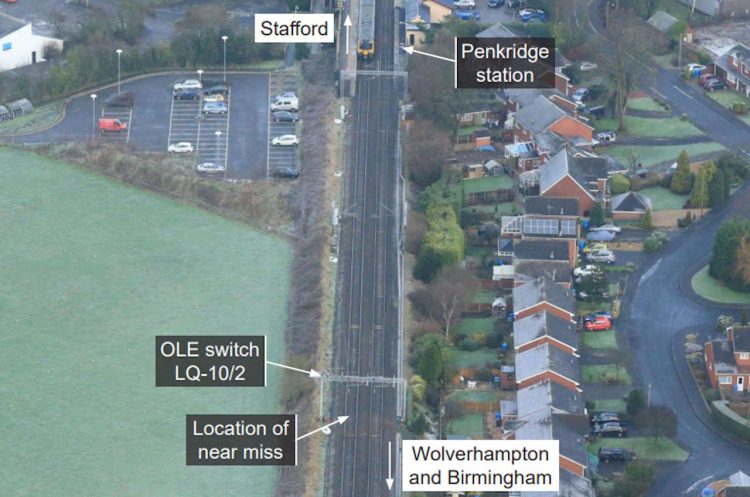The Rail Accident Investigation Branch (RAIB) has released its report on an incident in Staffordshire last July when two track workers had a near miss.
At 23:58 on 10th July 2022, two track workers who were working close to Penkridge station narrowly avoided being struck by a passing while. The train was travelling towards Stafford at 61 mph when the driver spotted the track workers standing on the line and sounded the locomotive’s horn.
After one of the track workers saw the train approaching, he warned his colleague and they both jumped clear of the track less than one second before the train passed their location.

The incident happened because a recognised safe system of work had not been put in place to protect the track workers from approaching trains.
The track workers were part of a larger group, but had left the group to isolate the overhead line by a switch south of Penkridge station. When the track workers left the group, they did not reach a mutual understanding with the Person in Charge (PIC) on the safety arrangements that would subsequently apply.
At the time of the incident, the track workers thought that the line they were standing on was blocked for the passage of trains, which was the case when they left the group. The PIC believed that the track workers were in a position of safety standing away from the track, and had allowed the line blockage to be removed without warning them.

points and location of relevant OLE equipment. . // Credit: Rail Accident Investigation Branch
RAIB’s investigation revealed no formal guidance was in place that covered the arrangements and responsibilities of staff when individuals move outside a PIC’s safe system of work, which was possibly an underlying factor. The RAIB also considered previous investigations that found a widespread acceptance that PICs and Controllers of Site Safety (COSSs) can actively observe and advise their work groups on-site over a greater distance than is practical or reasonable.

Following its investigation, RAIB made two recommendations to Network Rail:
- Improve the processes and guidance available to PICs and COSSs to help control the risks when groups split or change during a work activity.
- Understand how the practicalities of managing a group on-site can be improved.
Three learning points were also identified:
- The importance of clear communication.
- What duties a PIC should be allowed to undertake.
- The importance of making train-mounted CCTV available to help in safety investigations.
Andrew Hall, Chief Inspector of Rail Accidents said: “Network Rail has made huge progress in reducing the amount of work undertaken on lines open to traffic. However, the near miss at Penkridge, where a line blockage was being used, is a reminder that working on the track remains hazardous.
“In this incident, track workers split into two groups, with the person responsible for their safety remaining with one group and no safe system of work in place to cover the revised working arrangement. This was a result of a misunderstanding between the trackworkers and almost cost two people their lives.
“If a group of trackworkers has to be split, adequate arrangements must be put in place to ensure that the safety of all members of the group are maintained. Communication must be such that everyone fully understands what safe systems of work are in place.
“This investigation also shows how valuable forward-facing CCTV is for undertaking safety investigations. How close this near miss really was, only became apparent when our inspectors were able to review this vital evidence.”






Responses